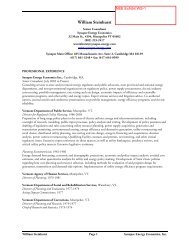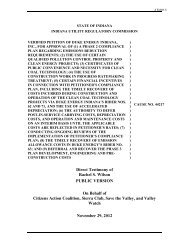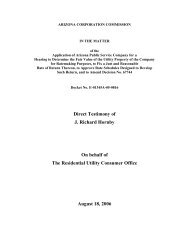Best Practices in Energy Efficiency Program Screening - Synapse ...
Best Practices in Energy Efficiency Program Screening - Synapse ...
Best Practices in Energy Efficiency Program Screening - Synapse ...
You also want an ePaper? Increase the reach of your titles
YUMPU automatically turns print PDFs into web optimized ePapers that Google loves.
used throughout. If the annual costs and benefits <strong>in</strong>clude the effects of <strong>in</strong>flation (i.e., are<br />
<strong>in</strong> nom<strong>in</strong>al dollars), then the discount rate should be <strong>in</strong> nom<strong>in</strong>al terms. If the annual<br />
costs and benefits are net of <strong>in</strong>flation (i.e., are <strong>in</strong> real dollars), then the discount rate<br />
should be <strong>in</strong> real terms.<br />
Account<strong>in</strong>g for the Time Value of Money<br />
This is the time preference issue mentioned above. Suppose that an <strong>in</strong>vestor is offered<br />
a guaranteed return for <strong>in</strong>vest<strong>in</strong>g funds. What would that return have to be to attract<br />
<strong>in</strong>vestments? Certa<strong>in</strong>ly it would have to cover the anticipated rate of <strong>in</strong>flation, but that will<br />
usually not be sufficient. Most people would rather have someth<strong>in</strong>g today than the same<br />
th<strong>in</strong>g <strong>in</strong> a year. Some extra return will be required.<br />
This extra return is usually called a “risk free discount rate,” because it assumes there is<br />
no risk associated with future benefits. (Risk will be discussed next.) In pr<strong>in</strong>ciple, such a<br />
risk free discount rate measures how much the decision maker on a given project values<br />
money this year versus next year. Note that the time value of money will be very<br />
different for different decision makers. This po<strong>in</strong>t will also be discussed below.<br />
Account<strong>in</strong>g for Risk<br />
Adjust<strong>in</strong>g for risk is the most difficult part of discount<strong>in</strong>g. Aga<strong>in</strong>, the risk adjustment<br />
depends on the perspective of the decision maker. Perhaps the simplest case is that<br />
where the decision maker is a utility’s management. The source of an <strong>in</strong>vestor-owned<br />
utility’s <strong>in</strong>vestment funds is a comb<strong>in</strong>ation of bond <strong>in</strong>vestors and equity <strong>in</strong>vestors,<br />
possibly <strong>in</strong>clud<strong>in</strong>g some preferred stockholders. Utility <strong>in</strong>vestments are typically<br />
discounted at the weighted average cost of capital (WACC), i.e., the weighted average<br />
yield of the company’s bonds and preferred stock along with its allowed return on equity.<br />
When apply<strong>in</strong>g WACC for discount<strong>in</strong>g, it is important to keep <strong>in</strong> m<strong>in</strong>d that these values<br />
come from markets that factor <strong>in</strong> all three issues: estimated <strong>in</strong>flation rates, time value of<br />
money, and perceived risk<strong>in</strong>ess of <strong>in</strong>vest<strong>in</strong>g <strong>in</strong> the utility.<br />
Application to the Cost Benefit Tests<br />
While it is important to understand the economic theory underly<strong>in</strong>g the application of<br />
discount rates, it is also important to recognize that the choice of discount rate is<br />
ultimately a policy call by the utility regulators. The choice of discount rates should be<br />
<strong>in</strong>formed by consider<strong>in</strong>g which party is be<strong>in</strong>g affected and what is the time value of<br />
money for that party, but it should also be <strong>in</strong>formed by consider<strong>in</strong>g how much weight the<br />
regulators want to give to the future costs and benefits associated with energy efficiency<br />
programs (especially benefits, because these occur well <strong>in</strong>to the future).<br />
Discount Rate for the Societal Cost Test<br />
The Societal Test, as its name implies, should use a discount rate based on society’s<br />
preferences. Compared to <strong>in</strong>dividuals and firms, society should have a broader tolerance<br />
for receiv<strong>in</strong>g benefits <strong>in</strong> the future, and also be better able to access funds at a lower<br />
borrow<strong>in</strong>g cost. In this case, the discount rate should be relatively low.<br />
<strong>Energy</strong> efficiency <strong>in</strong>vestments for special groups of customers, particularly low <strong>in</strong>come<br />
and at-risk populations could also be viewed with a societal discount rate for several<br />
reasons. These customers are generally receiv<strong>in</strong>g some degree of support from society<br />
at large, so the <strong>in</strong>vestment can appropriately be viewed <strong>in</strong> a societal context. It is society<br />
<strong>Best</strong> <strong>Practices</strong> <strong>in</strong> <strong>Energy</strong> <strong>Efficiency</strong> <strong>Program</strong> Screen<strong>in</strong>g | www.nhpci.org | 51







